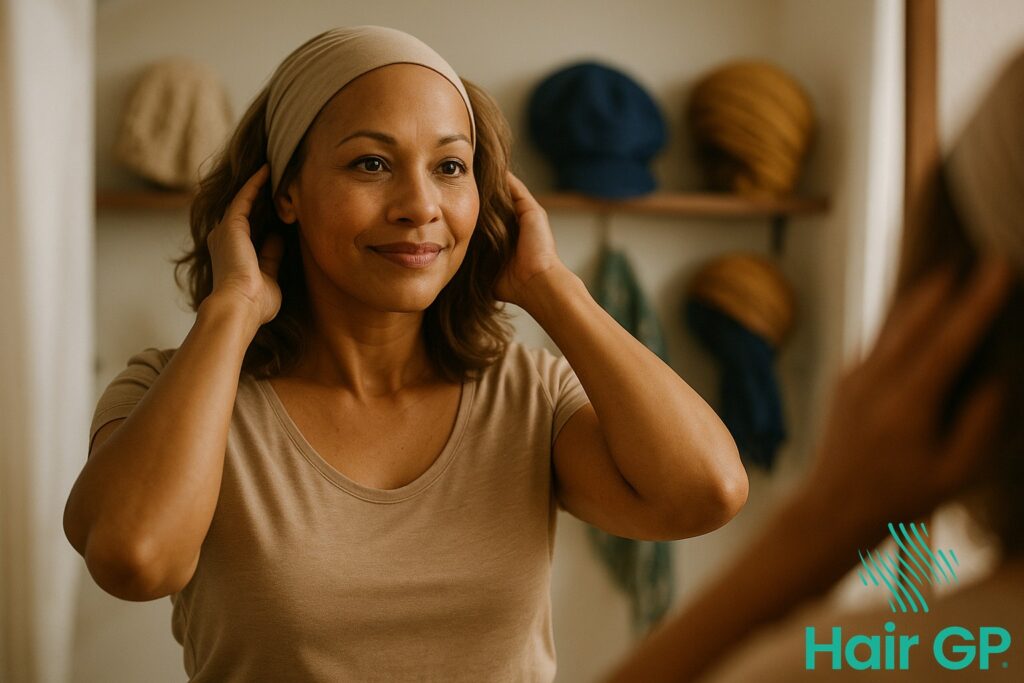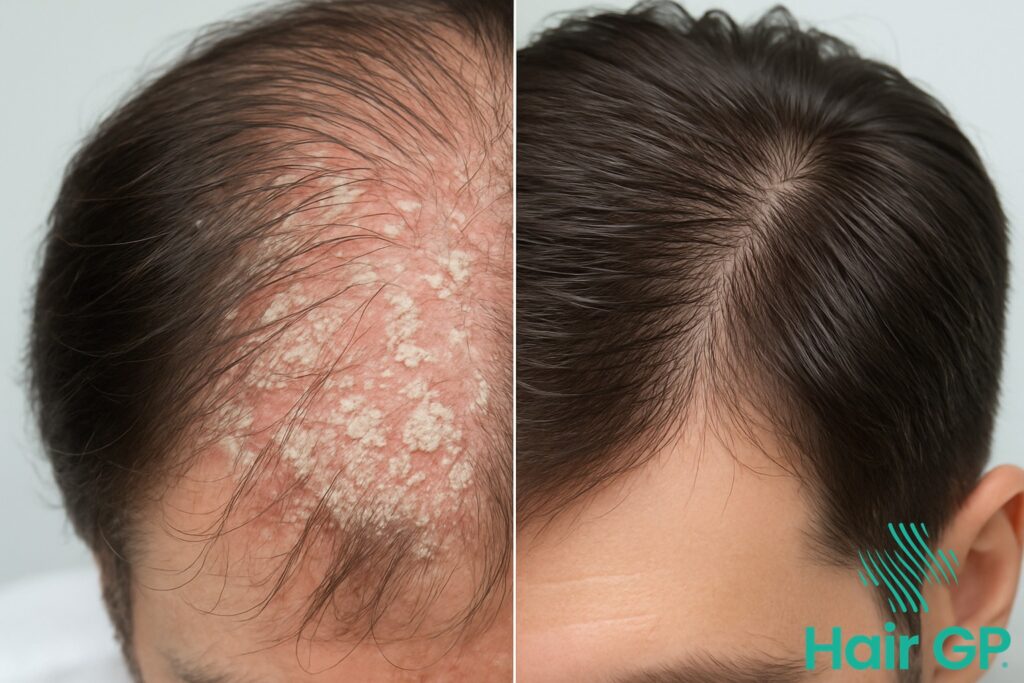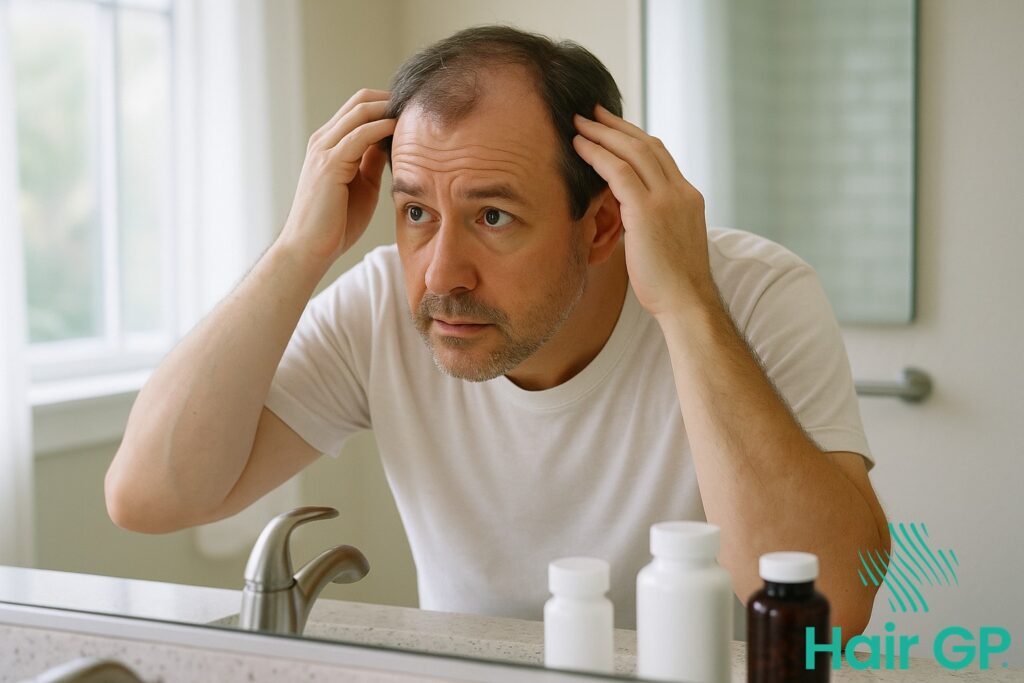Introduction
Experiencing hair loss during cancer treatment can be one of the most visible and emotionally challenging aspects of chemotherapy. Whilst the focus remains on healing and recovery, the practical and psychological impact of losing your hair deserves thoughtful attention and support. This comprehensive guide offers evidence-based advice and reassuring solutions for managing this transition with dignity and comfort.
Whether you’re considering human hair wigs, exploring synthetic wig options, or seeking alternatives to traditional wigs altogether, understanding your choices empowers you to make decisions that suit your lifestyle and personal preferences. From selecting the perfect wig caps for sensitive scalps to discovering stylish headwear alternatives, this guide addresses both the practical and emotional aspects of chemotherapy-induced hair loss.
Throughout these pages, you’ll discover the science behind why hair falls out during treatment, learn how to compare different wig types and materials, and understand proper fitting techniques for maximum comfort. We’ll explore creative alternatives like turbans and headscarves, whilst providing essential advice on caring for your scalp during and after treatment. You’ll also find valuable information about professional wig services, support programmes, and insurance options that can ease the financial burden.
As you navigate this journey, remember that hair loss is temporary. This guide will support you through every stage, from initial hair thinning to the exciting phase of regrowth, offering practical tips and emotional reassurance along the way. Your comfort, confidence, and wellbeing remain our primary focus throughout this comprehensive resource.
Key Takeaways – TL/DR
- Human hair wigs offer the most natural look but require more maintenance than synthetic options
- Proper wig cap selection is crucial for comfort during chemotherapy treatment
- Alternative headwear like turbans and soft hats can be equally stylish and comfortable
- Scalp care remains important even during hair loss to promote healthy hair growth
- Many cancer support organizations offer free wig services for breast cancer patients
Understanding Chemotherapy-Induced Hair Loss
Chemotherapy induced alopecia affects approximately 65% of cancer patients receiving systemic treatment, representing one of the most distressing side effects of cancer therapy[1]. Understanding the timeline and pattern of hair loss helps patients prepare emotionally and practically for this temporary but significant change. The process varies considerably between individuals and treatment regimens, making personalised support essential.
When Does Hair Loss Typically Begin?
Hair loss typically commences 2-3 weeks after initiating chemotherapy, though this timeline varies significantly depending on the specific drugs administered[2]. Some patients experience gradual hair thinning over several weeks, whilst others notice sudden, more dramatic hair falls within days. The pattern often begins with scalp tenderness or tingling sensations, followed by hair coming out in clumps during washing or brushing.
Different chemotherapy agents produce varying degrees of alopecia. Taxanes and anthracyclines commonly cause complete hair loss, whilst other medications may result in partial hair thinning. Understanding your specific treatment protocol helps set realistic expectations about the extent and timing of potential hair loss during cancer treatment.
Emotional Preparation and Support
The psychological impact of losing one’s hair during chemotherapy extends beyond physical appearance, often affecting self-identity and confidence. Many cancer centres offer specialised counselling services to help patients navigate these emotional challenges. Support groups provide invaluable peer connections, allowing individuals to share experiences and coping strategies with others facing similar circumstances.
Preparing emotionally involves acknowledging the temporary nature of chemotherapy induced alopecia whilst allowing yourself to grieve this loss. Consider exploring wig options before hair loss begins, taking control photos for reference, and involving trusted friends or family in the process. Remember that experiencing distress about hair loss doesn’t diminish your strength or courage in facing cancer treatment.
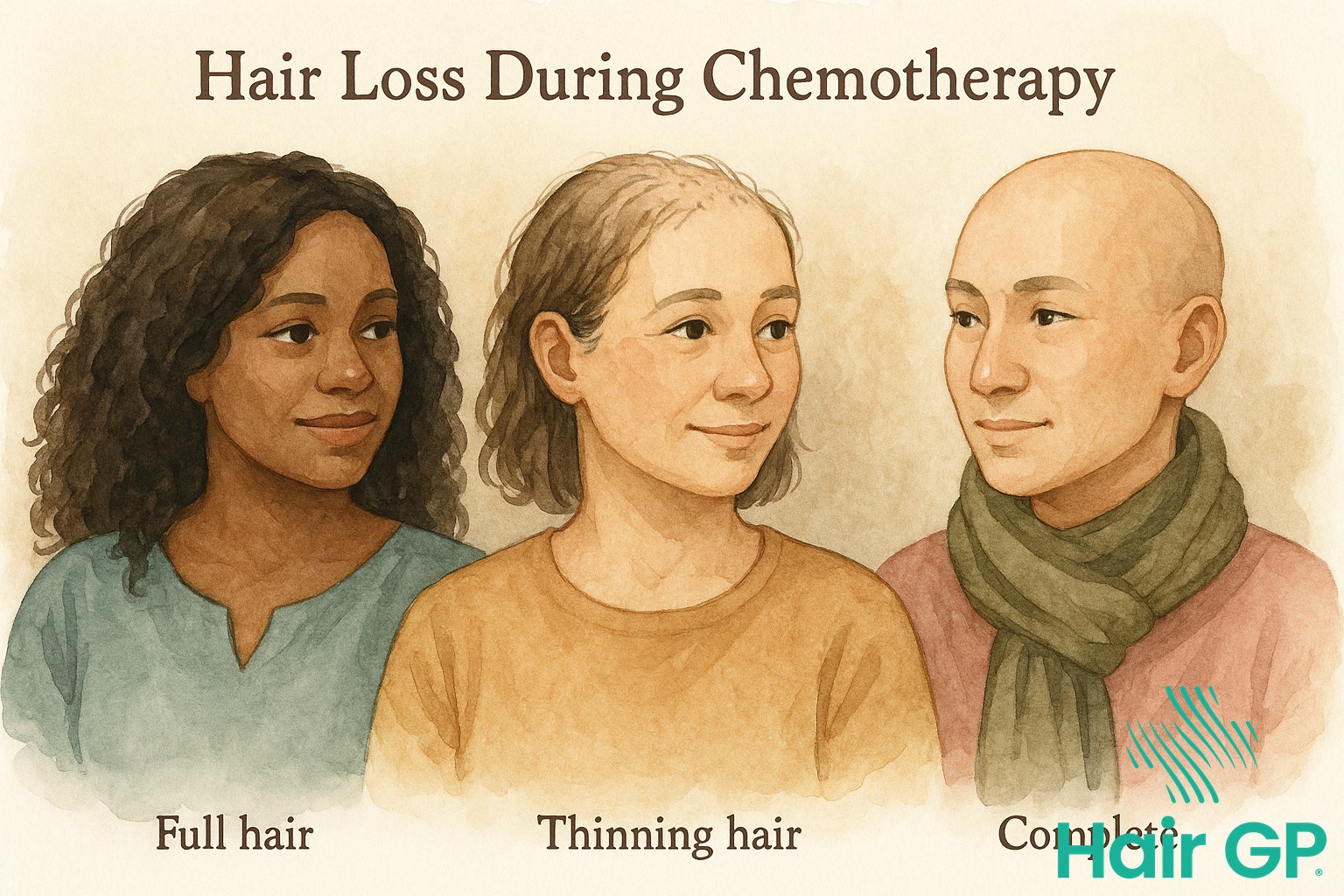
Choosing Between Human Hair and Synthetic Wigs
Selecting the right wig material is a deeply personal decision that depends on your lifestyle, budget, and treatment journey. Understanding the distinct characteristics of human hair wigs and synthetic options empowers you to make a choice that aligns with your practical needs and emotional wellbeing.
Benefits of Human Hair Wigs
Human hair wigs offer unparalleled versatility and authenticity that many patients find reassuring during treatment. The ability to use heat styling options, including hair straighteners, curling tongs, and blow dryers, allows you to change your look as often as you wish. This styling flexibility can be particularly valuable when maintaining a sense of normalcy is important.
Real hair provides natural movement that responds to wind and motion just like your own hair would. The longevity of human hair pieces, often lasting 1-2 years with proper care, makes them a worthwhile investment despite the higher initial cost. The texture and shine of human hair closely mimics natural hair, offering confidence in professional and social settings.
Advantages of Synthetic Wigs
Synthetic hair technology has advanced remarkably, offering benefits that make synthetic wigs an excellent choice for many patients. The pre-styled convenience means your wig maintains its shape even after washing, eliminating daily styling routines when energy levels may be low.
Colour retention in synthetic hair surpasses natural alternatives, maintaining vibrancy without fading or requiring colour treatments. Weather resistance is another significant advantage – synthetic fibres won’t frizz in humidity or lose their style in rain, providing reliable consistency regardless of conditions.
Making Your Decision
Budget considerations often play a crucial role, with synthetic options typically costing 50-80% less than human hair alternatives. Consider your lifestyle factors carefully: if you enjoy experimenting with styles or need heat-styling capability, human hair may suit you better. However, if minimal maintenance time appeals to you, particularly during treatment when fatigue is common, a synthetic wig offers practical advantages.
Many patients find having both options beneficial – a higher-quality piece for special occasions and affordable synthetic alternatives for everyday wear.
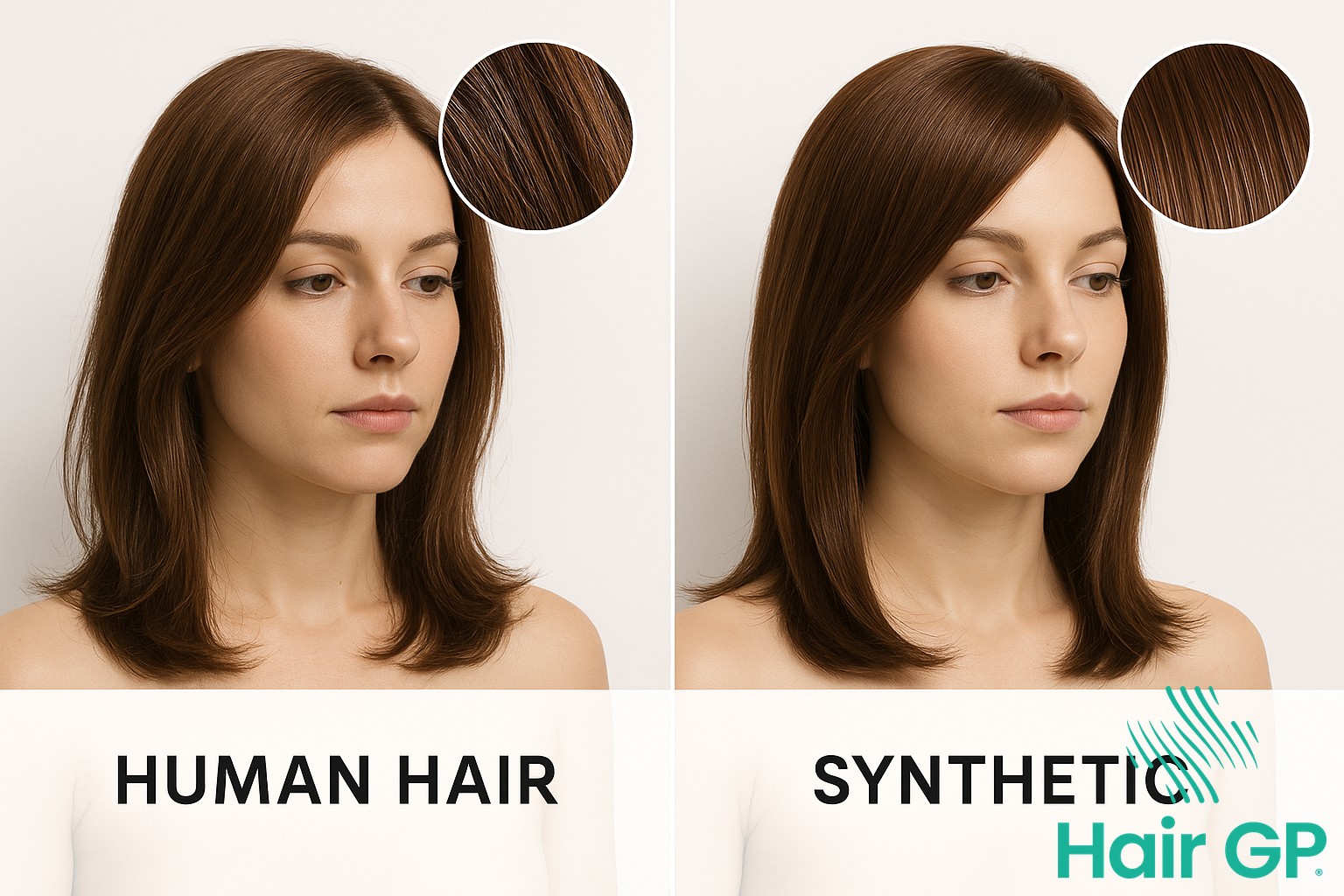
Essential Wig Cap Selection and Fitting
Selecting the right wig cap forms the foundation of comfortable wig wearing during chemotherapy treatment. Understanding proper measurement techniques and choosing suitable materials ensures optimal comfort for sensitive scalps whilst maintaining a secure, natural appearance throughout your cancer journey.
Measuring for the Right Fit
Accurate head measurements ensure your wig cap provides comfort without causing pressure or slipping. Begin by measuring your head circumference using a soft tape measure, positioning it approximately one inch above your eyebrows and around the fullest part of your head. Record this measurement in both inches and centimetres for reference when consulting size charts.
Consider that chemotherapy may cause slight facial swelling, so add half an inch to your initial measurement for flexibility. Most wig caps accommodate a range of sizes, but knowing your exact hat size helps select options that won’t compress sensitive areas. Pay attention to your face shape when choosing cap styles, as certain designs complement different facial structures whilst maintaining your natural hairline appearance.
Materials for Sensitive Scalps
Bamboo wig caps offer exceptional benefits for chemotherapy patients, providing natural antibacterial properties and superior breathability. The silky-smooth texture minimises friction against delicate skin whilst effectively managing moisture throughout extended wear.
Cotton options provide reliable comfort for sensitive scalps, offering gentle support without synthetic irritation. Choose organic cotton varieties when possible, as these reduce exposure to potential allergens. Some patients find combining cotton caps with hypoallergenic wig tape along the edges provides additional security without compromising skin health. Always select materials that allow proper air circulation to prevent overheating and maintain scalp comfort during treatment.
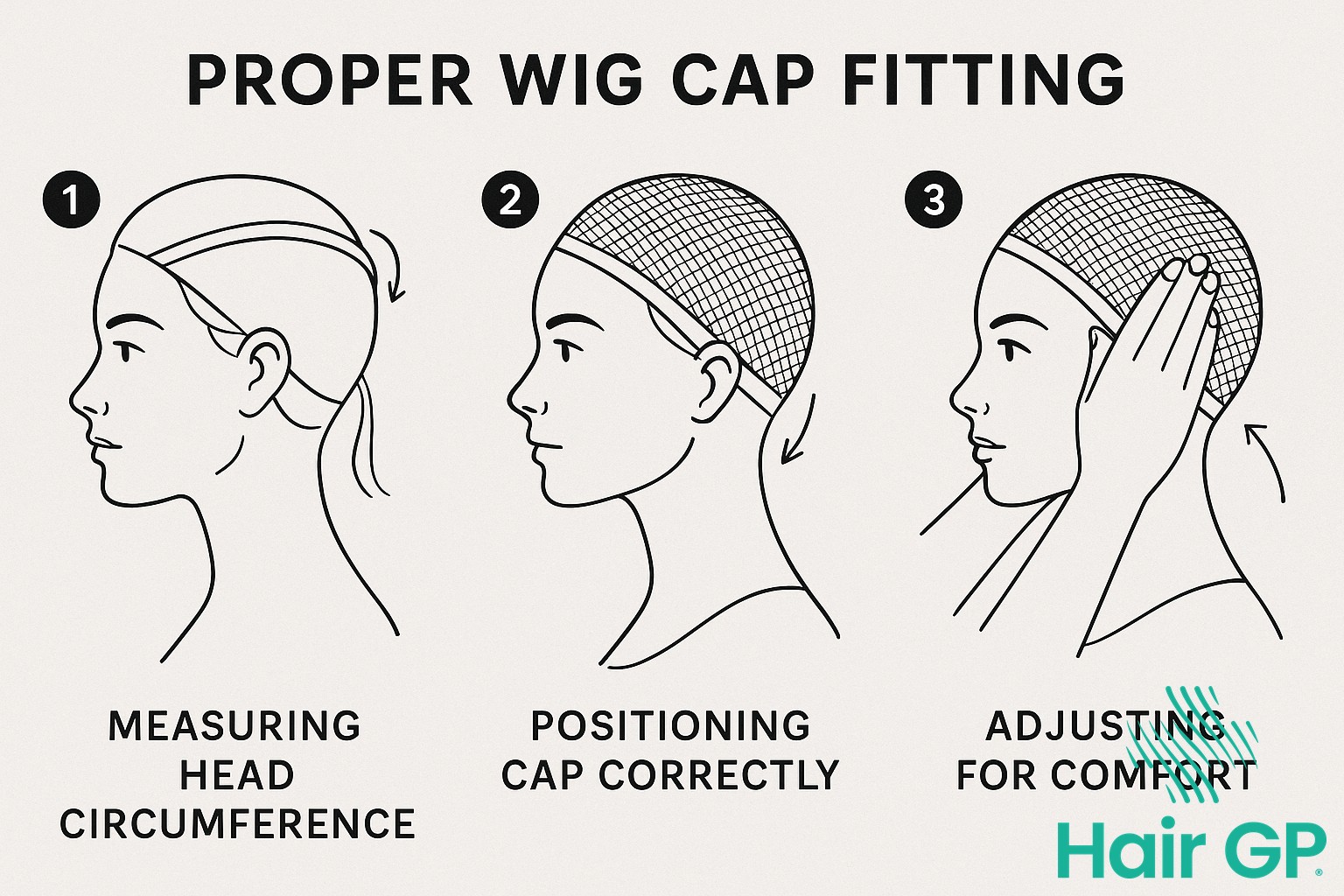
Alternative Headwear Options Beyond Wigs
When navigating cancer treatment, wigs aren’t the only solution for head coverage – numerous comfortable and stylish headwear alternatives exist that offer flexibility and ease. From elegant turbans to cosy soft hat options, these alternatives provide practical coverage whilst allowing you to express your personal style without the maintenance requirements of a wig.
Turbans and Head Wraps
Modern turbans have evolved far beyond traditional designs, offering cancer patients sophisticated and comfortable options. Pre-tied turbans eliminate the complexity of wrapping techniques, providing instant coverage with minimal effort. These ready-to-wear styles come in bamboo, cotton, and modal fabrics that feel gentle against sensitive scalps. For those preferring customisation, learning basic wrapping techniques with rectangular scarves creates versatile looks. Stretchy jersey fabrics work particularly well, conforming to your head shape whilst staying secure throughout the day.
Scarves and Bandanas
A versatile headscarf collection offers endless styling possibilities during treatment. Square scarves can be folded diagonally and tied at the nape, whilst rectangular scarves wrap beautifully into turban-style coverings. Seasonal fabric choices enhance comfort – lightweight silks and cottons for summer, whilst cashmere blends provide warmth during winter months. Pattern selection becomes an enjoyable way to coordinate with outfits, from bold prints that make statements to subtle neutrals that complement any wardrobe. Adding a headband underneath prevents slipping and adds extra coverage around the hairline.
Hats for Every Season
Practical hat options ensure comfortable coverage year-round. Winter calls for soft bamboo beanies that won’t irritate sensitive skin, whilst wide-brimmed summer sun hats protect from UV exposure during treatment. For indoor wear, lightweight sleep caps and jersey hats provide coverage without overheating. Many cancer-specific hat designs feature built-in volume at the crown, creating natural-looking fullness. This other headwear category includes innovative options like hats with removable hair attachments, offering wig-like appearance with hat comfort.
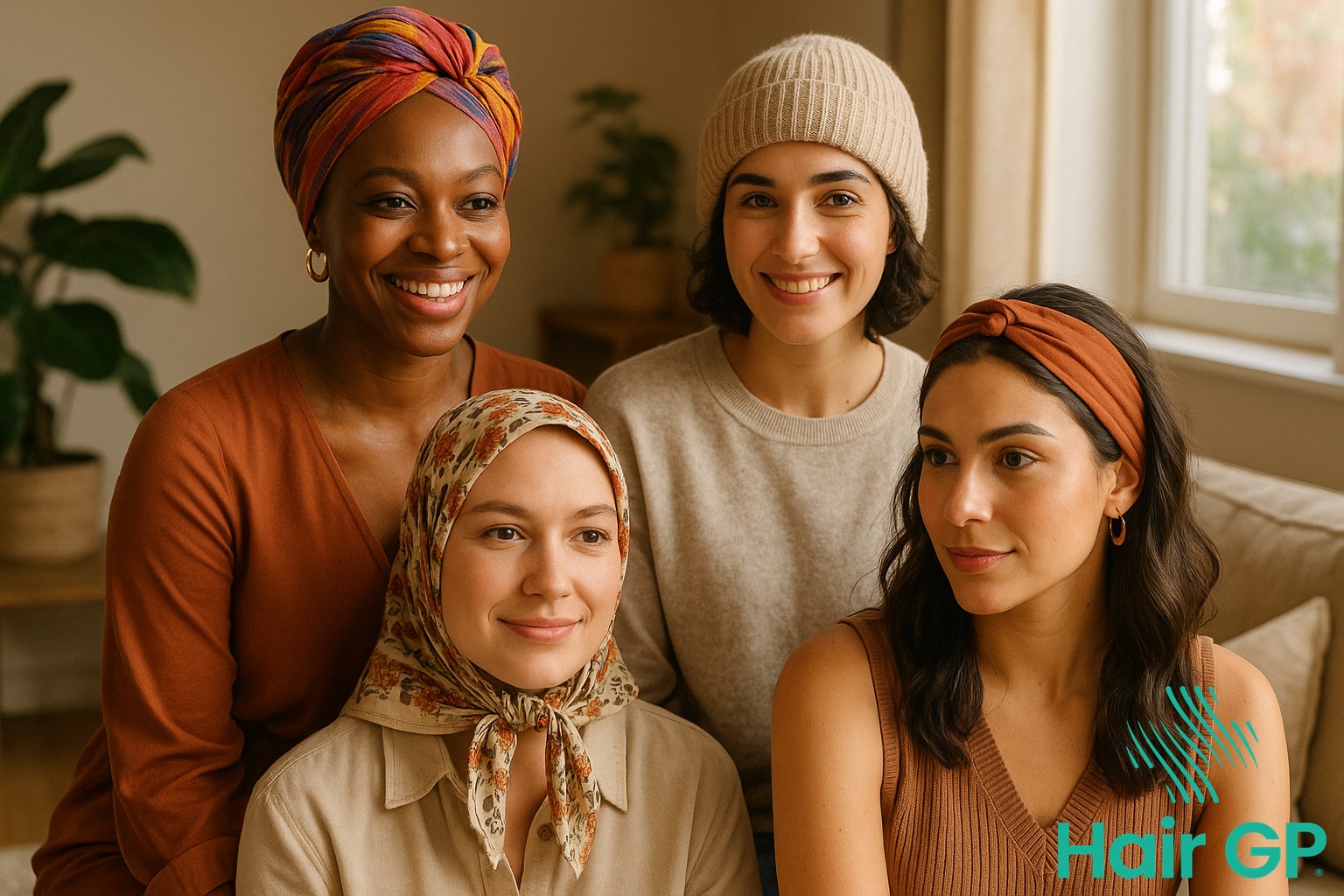
Scalp Care During and After Treatment
Proper scalp care during chemotherapy and radiotherapy treatment plays a vital role in maintaining scalp health and preparing for future hair regrowth. A dedicated routine of gentle cleansing, moisturising, and protection helps prevent irritation whilst creating optimal conditions for healthy hair to return once treatment concludes.
Gentle Cleansing Routines
Maintaining scalp hygiene requires adjusting your usual washing routine to accommodate increased sensitivity. Choose a mild, fragrance-free shampoo specifically formulated for sensitive scalps, avoiding products with sulphates or harsh detergents. Lukewarm water proves most comfortable, as hot water can increase scalp irritation and dryness during treatment.
When washing, use gentle circular motions with your fingertips rather than vigorous scrubbing. Pat your scalp dry with a soft towel instead of rubbing, which can cause unnecessary friction. Many patients find that washing every 2-3 days strikes the right balance between cleanliness and avoiding over-drying.
Protecting Your Scalp
Your scalp becomes particularly vulnerable to sun damage during treatment, requiring diligent protection. Apply broad-spectrum SPF 30 or higher sunscreen to exposed areas, reapplying every two hours when outdoors. Wide-brimmed hats, scarves, or wigs provide additional physical protection from harmful UV rays.
Studies show scalp cooling can reduce chemotherapy-induced hair loss by 50-80% in suitable candidates [3]. However, radiotherapy to the head may cause permanent hair loss in treated areas, making scalp protection even more crucial. Avoid potential irritants including hair dyes, perms, and styling products containing alcohol until hair growth returns and your oncologist approves their use.
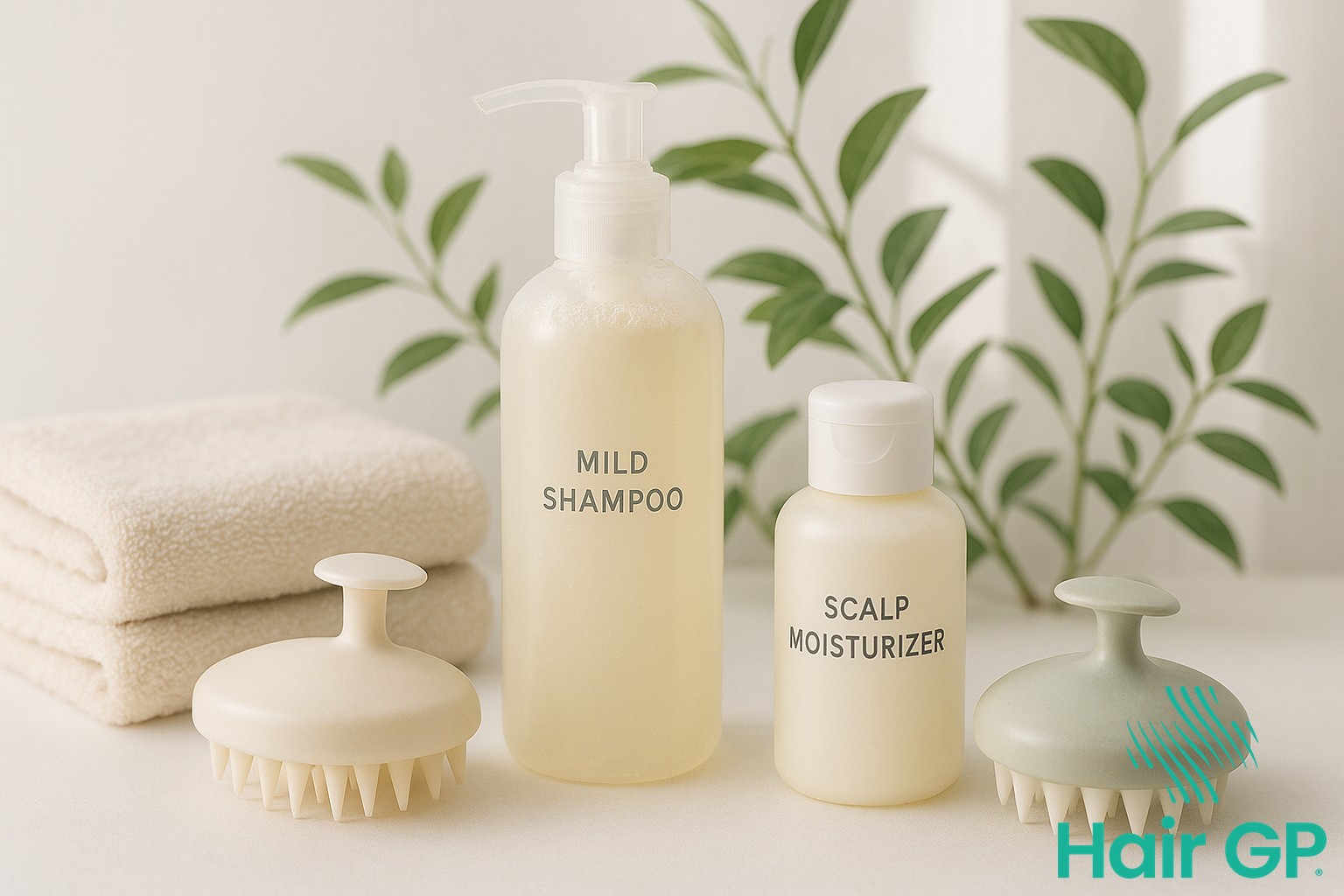
Finding Professional Wig Services and Support
Finding the right professional support makes a significant difference in your wig journey during cancer treatment. From expert wig fitters to charitable organisations, numerous resources exist to help you access quality wigs and personalised services that suit your needs and budget.
Working with Wig Specialists
A professional wig specialist offers invaluable expertise through personalised consultations tailored to your specific requirements. These trained professionals assess your face shape, lifestyle, and personal preferences to recommend suitable options. Most wig fitters provide private fitting rooms where you can try various styles comfortably and confidentially. Beyond initial selection, a reputable wig shop typically offers ongoing styling services, including cutting, colouring, and maintenance guidance specific to your chosen wig type.
When selecting a wig supplier, look for those specialising in medical hair loss who understand the unique needs of cancer patients. These specialists often maintain relationships with insurance providers and can assist with documentation requirements for coverage claims.
Free and Low-Cost Wig Programs
Several charitable organisations provide free wig services to cancer patients experiencing financial hardship. Major cancer societies often maintain wig banks or voucher programmes, whilst local support groups frequently organise wig donation drives. Many hospitals partner with these programmes, offering direct referrals to patients.
Insurance coverage varies significantly between providers, but many policies include provisions for “cranial prostheses” when prescribed by an oncologist. Contact your insurance company early in treatment to understand coverage limits and required documentation. Additionally, some wig suppliers offer payment plans or sliding scale fees based on financial need, ensuring quality hair solutions remain accessible regardless of economic circumstances.
Managing the Transition as Hair Grows Back
The journey back to natural hair growth after chemotherapy brings both excitement and uncertainty. As hair grows back, patients navigate texture changes, new colours, and the emotional process of transitioning from wigs to their own hair.
Understanding Regrowth Patterns
Hair typically begins returning 3-6 weeks after treatment ends, though timelines vary considerably between individuals. Initial growth often appears as soft fuzz, gradually developing into fuller strands. Many patients experience surprising texture changes – straight hair may return curly, whilst previously thick hair might feel finer. Colour variations are equally common, with hair sometimes emerging darker or lighter than before, occasionally showing grey strands that weren’t previously present. This ‘chemo curl’ phenomenon typically settles within 6-12 months as follicles recover. Understanding these changes helps with coping emotionally during this transitional phase.
Styling New Growth
Managing short, new hair requires gentle care and patience. Choose sulphate-free shampoos and lightweight conditioners designed for thinning hair to avoid weighing down delicate strands. Avoid heat styling initially, opting instead for air-drying and soft-hold products. A professional hair cut around the 2-3 inch mark helps shape growth and remove any uneven patches. Many find that regular trims every 4-6 weeks encourage healthier regrowth patterns. Transitioning from wigs happens gradually – some alternate between wig-wearing and natural hair days, whilst others switch to headscarves or hats as intermediate options. Trust your comfort level and remember there’s no rush to abandon wigs completely.
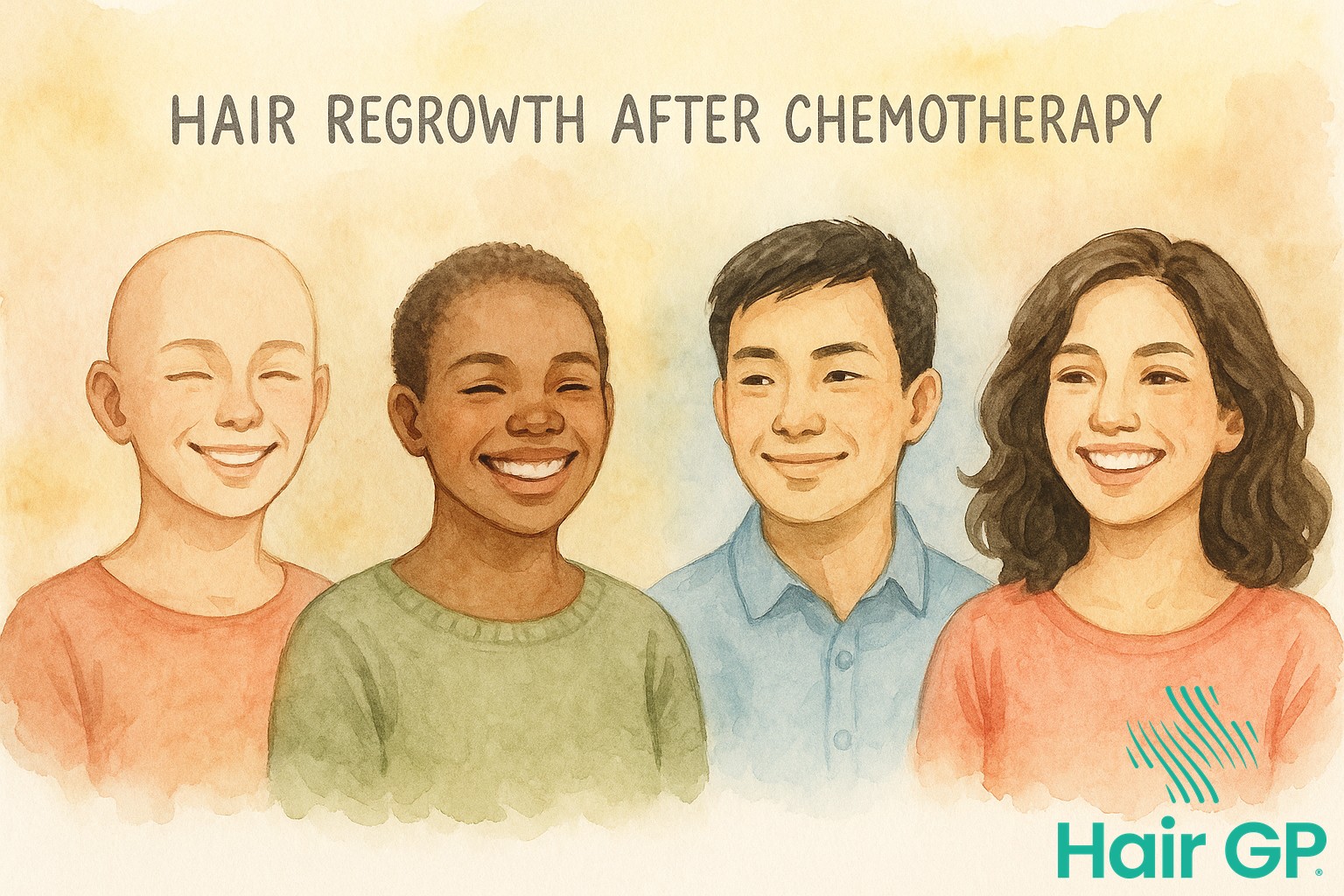
Conclusion
Navigating hair loss during cancer treatment presents unique challenges, but understanding your options empowers you to make choices that help you feel comfortable and confident. Whether you’re amongst the many breast cancer patients exploring wig options or someone seeking alternative headwear solutions, remember that this journey is deeply personal. The variety of available choices—from human hair wigs to synthetic alternatives, turbans to scarves—ensures you’ll find something that suits your lifestyle and preferences.
Many cancer centres now offer programmes to recycle wigs, allowing patients to donate their pieces after chemotherapy treatment concludes, helping others beginning their journey. This generous act transforms a temporary need into lasting support for the community. Remember that hair loss from chemotherapy affects approximately 65% of patients, making you part of a vast support network of individuals who understand your experience.
As you progress through treatment, be patient with yourself and your changing appearance. Most importantly, focus on your healing journey. Your hair will likely return once treatment ends, often with interesting changes in texture or colour. Until then, embrace the options available, lean on your support system, and remember that each day brings you closer to recovery.
Frequently Asked Questions
Most people experience hair loss within 2-3 weeks of their first chemotherapy treatment. It’s best to shop for wigs and headwear before treatment begins, when you have more energy and can match your natural hair colour if desired. This also gives you time to get comfortable with your chosen headwear options.
Human hair wigs offer styling versatility and a very natural look, but they require more maintenance and are significantly more expensive than synthetic options. Many cancer patients find high-quality synthetic wigs perfectly suitable for temporary use during treatment. Consider your lifestyle, budget, and how long you’ll need the wig when making your decision.
Many insurance plans cover ‘cranial prostheses’ (medical wigs) with a prescription from your oncologist. Additionally, organizations like Cancer Research UK, NHS BSA, and local cancer support groups have fantastic information on who is eligible for these via the NHS. Contact your insurance provider and local cancer center for specific programs in your area.
Keep your scalp clean with gentle, fragrance-free shampoo and lukewarm water. Moisturize daily with a mild, unscented lotion. Always protect your scalp from sun exposure with SPF 30+ sunscreen or head coverings. Avoid harsh chemicals, hot water, and vigorous rubbing. Some patients find scalp massage with gentle oils soothing.
Once your hair has grown back, you can donate your wig to organizations that recycle wigs for other cancer patients. Many cancer centers and wig shops have donation programs. Ensure the wig is clean and in good condition. Some people also keep their wig as a backup or for special occasions when they want a different hairstyle.
References
- Trueb RM. Chemotherapy-induced alopecia. Semin Cutan Med Surg. 2009;28(1):11-14.
- Paus R, Haslam IS, Sharov AA, Botchkarev VA. Pathobiology of chemotherapy-induced hair loss. Lancet Oncol. 2013;14(2):e50-59.
- Nangia J, Wang T, Osborne C, et al. Effect of a Scalp Cooling Device on Alopecia in Women Undergoing Chemotherapy for Breast Cancer: The SCALP Randomized Clinical Trial. JAMA. 2017;317(6):596-605.

